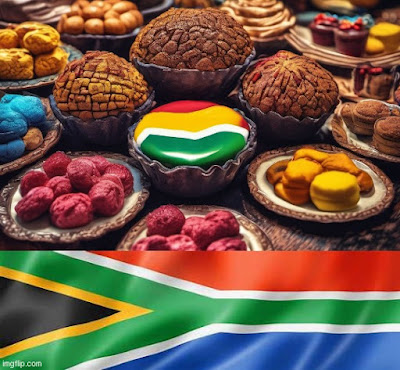
South African desserts, a tapestry of flavors and traditions, offer a delightful journey through the nation's culinary heritage. From centuries-old recipes to modern interpretations, South African desserts showcase the country's diverse culture, history, and abundant natural resources. In this comprehensive exploration, we will delve into the historical roots, key ingredients, popular desserts, regional variations, cultural significance, and the evolution of South African desserts.
## Historical Roots and Culinary Influences
South African desserts have evolved over centuries, shaped by the country's unique history and multicultural influences. The indigenous people of South Africa, including the Khoisan and various Bantu-speaking groups, had their own traditional desserts based on locally available ingredients such as fruits, nuts, and grains.
The arrival of European settlers, particularly the Dutch, in the 17th century brought new ingredients and culinary techniques. Dutch desserts like koeksisters (a syrupy, twisted pastry) and melktert (a milk-based tart) made their mark on South African cuisine.
Later, the British, French, Portuguese, and Indian communities also made significant contributions to the dessert culture. Indian influences, especially, brought a variety of spices and ingredients like cardamom, coconut, and sweetened condensed milk.
## Key Ingredients and Flavors
South African desserts make use of an array of indigenous and introduced ingredients. Here are some key components:
1. **Fruits**: South Africa's diverse climate allows for the growth of a wide range of fruits, including citrus fruits, apples, pears, grapes, and more. These fruits often find their way into desserts, whether fresh or cooked.
2. **Dairy**: Milk, cream, and condensed milk are fundamental components of many South African desserts, imparting a rich and creamy texture.
3. **Grains**: Maize (corn), wheat, and sorghum are staple grains, often used to make various desserts like porridges, puddings, and bread.
4. **Sugars**: From sugar cane to honey and syrups like rooibos syrup, sweeteners play a vital role in South African desserts.
5. **Spices**: Aromatic spices like cinnamon, nutmeg, ginger, and cardamom are commonly used to add depth and flavor to desserts.
6. **Nuts**: Almonds, pecans, and macadamia nuts are frequently used, either as a garnish or as part of the dessert itself.
7. **Indigenous Ingredients**: African ingredients like amadumbe (taro), mampoer (a traditional liquor), and buchu (an herb) also find their way into some traditional desserts.
## Popular South African Desserts
### 1. **Malva Pudding**:
Malva pudding is a rich, warm sponge pudding served with a sticky caramelized sauce. It's a classic South African dessert, often enjoyed during colder months.
### 2. **Koeksisters**:
Koeksisters are syrupy, deep-fried pastries with a braided shape. They're a favorite at fairs, markets, and family gatherings.
### 3. **Melktert (Milk Tart)**:
Melktert is a sweet pastry crust filled with a creamy milk-based filling, usually flavored with cinnamon.
### 4. **Peppermint Crisp Tart**:
This no-bake dessert layers biscuits, caramel, cream, and a popular South African chocolate bar called Peppermint Crisp.
### 5. **Rooibos Custard Slices**:
These are layers of crispy pastry filled with a rooibos-flavored custard filling and topped with icing sugar.
### 6. **Hertzoggie**:
Hertzoggies are sweet, coconut-filled tartlets named after General J.B.M. Hertzog, a former South African Prime Minister.
### 7. **Boeber**:
Boeber is a traditional Cape Malay sweet milk drink made with vermicelli, sago pearls, and flavored with cardamom and cinnamon.
### 8. **Amarula Malva Pudding**:
A variation of the malva pudding made with Amarula cream liqueur, adding a unique flavor.
### 9. **Potato Pudding**:
A sweet pudding made from potatoes, often served during holidays and special occasions.
### 10. **Watermelon Jelly**:
A refreshing dessert made from watermelon juice, gelatin, and condensed milk.
## Regional Variations
South Africa's diverse landscapes and cultural mix influence regional desserts. Here are a few examples:
1. **Cape Malay Desserts**:
The Cape Malay community, descendants of Indonesian and Malaysian slaves, have a unique dessert culture. Spices, dried fruit, and flavors like rosewater and cardamom are common in their desserts.
2. **Zulu Desserts**:
In Zulu cuisine, ingredients like maize, millet, and sorghum are frequently used in desserts. Isijingi (a steamed bread pudding) and amasi (fermented milk) desserts are popular.
3. **Xhosa Desserts**:
The Xhosa people often use ingredients like pumpkin, maize, and sweet potatoes in their desserts. Umngqusho is a dessert made from samp (crushed corn kernels) and beans.
## The Significance of South African Desserts
Desserts in South Africa have cultural, historical, and social significance. They often play a role in religious and traditional ceremonies, marking special occasions like weddings, births, and coming-of-age celebrations.
Desserts also provide a way to preserve cultural heritage. Recipes passed down through generations are a source of pride and connection to one's roots. Moreover, the sharing of desserts fosters community and togetherness.
## The Evolution of South African Desserts
In recent years, there has been a resurgence of interest in traditional South African desserts. Chefs and food enthusiasts are reinventing classic recipes, presenting them in new and innovative ways while still honoring the essence of the original dishes.
Moreover, the blending of different cultures has led to fusion desserts, incorporating South African flavors and ingredients into international dessert recipes, creating a delightful cross-cultural culinary experience.
## Conclusion
South African desserts, steeped in history and bursting with flavor, offer a rich and diverse culinary adventure. From the sweet and sticky koeksisters to the comforting warmth of malva pudding, each dessert tells a story of the nation's past and present. As South Africa continues to evolve and embrace its multicultural identity, its desserts will undoubtedly continue to reflect this beautiful tapestry of cultures, flavors, and traditions.





%20(1).png)

